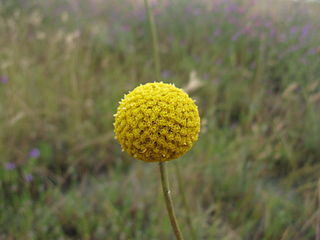
Pycnosorus is a genus of six species of plants in the daisy family Asteraceae. Commonly known as billy buttons or drumsticks, they are annual or perennial herbs or small shrubs with a cylindrical to spherical head of up to 200 daisy-like "flowers". Each "flower" is a pseudanthium consisting of between three and eight florets surrounded by bracts. The petals are joined to form a small tube and the florets with their surrounding bracts are yellow or golden-yellow.

Melaleuca huegelii, commonly known as chenille honey-myrtle, is a plant in the myrtle family, Myrtaceae and is endemic to the south-west coastal areas of Western Australia. It has small, almost scale-like leaves and flower spikes sometimes more than 100 millimetres (4 in) long on the ends many of its branches.

Verticordia huegelii, commonly known as variegated featherflower, is a flowering plant in the myrtle family, Myrtaceae and is endemic to the south-west of Western Australia. It is a sometimes an erect shrub, sometimes sprawling to almost prostrate. It has linear leaves and very feathery flowers in spring. The flowers are usually cream-coloured or white, becoming pinkish and reddish or maroon as the flowers age, giving a variegated appearance to the display.
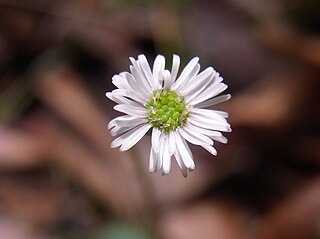
Lagenophora is a genus of flowering plants in the sunflower family. Species occur in South-east Asia, Australia, New Zealand, as well as Central and South America.
Enumeratio plantarum quas in Novae Hollandiæ ora austro-occidentali ad fluvium Cygnorum et in sinu Regis Georgii collegit Carolus Liber Baro de Hügel is a description of the plants collected at the Swan River colony and King George Sound in Western Australia. The author, Stephan Endlicher, used a collection arranged by Charles von Hügel to compile the first flora for the new settlements. Hugel visited the region during 1833–1834, several years after the founding of the colony. The work provided formal descriptions, in Latin, of new species and genera of plants. The single installment was produced in Europe by Endlicher in 1837, the work also included contributions by Eduard Fenzl, George Bentham, Heinrich Wilhelm Schott.
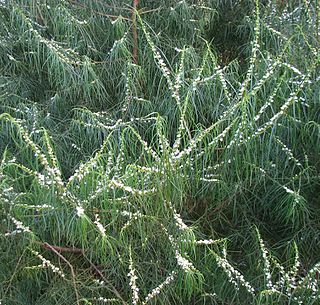
Myoporum floribundum, commonly known as weeping myoporum or slender myoporum, is a sour-smelling glabrous shrub in the family Scrophulariaceae endemic to a small area of New South Wales and Victoria in Australia. It has long, thin, drooping leaves and profuse white flowers in clusters along the stems in spring. Although it is uncommon in nature, it has long been available as a popular garden plant.
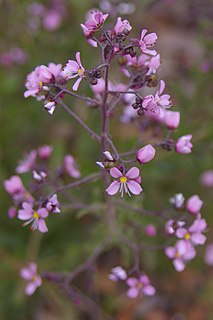
Diplopeltis hueglii is a shrub species in the soapberry family, Sapindaceae. It is endemic to Western Australia. Plants grow to between 0.1 and 1.5 metres high. White, pink or purple flowers are produced between April and December in the species' native range.
Eutaxia parvifolia is a shrub species in the family Fabaceae. It is endemic to Western Australia. Plants are up to 2 metres high and produce yellow and red flowers between August and December in the species' native range.

Eucalyptus occidentalis, commonly known as the flat topped yate or the swamp yate, is a tree that is native to Western Australia. The Noongar names for the tree are Mo or Yundill.

Acacia huegelii is a shrub belonging to the genus Acacia and the subgenus Phyllodineae native to Western Australia.
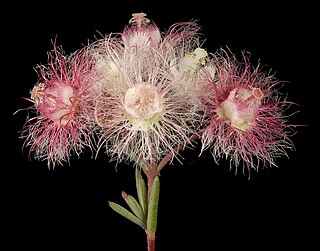
Verticordia huegelii var. huegelii, commonly known as variegated featherflower, is a flowering plant in the myrtle family, Myrtaceae and is endemic to the south-west of Western Australia. It is an upright, slender or bushy shrub, with creamish-white flowers turning pink or reddish maroon as they age, giving the plant a variegated appearance. It is similar to Verticordia huegelii var. decumbens but is more upright than that variety and lacks a lignotuber.

Verticordia huegelii var. decumbens, commonly known as variegated featherflower, is a flowering plant in the myrtle family, Myrtaceae and is endemic to the south-west of Western Australia. It is an almost prostrate shrub, with creamish-lemon coloured flowers turning pink then red as they age, giving the plant a variegated appearance. It is similar to Verticordia huegelii var. huegelii but has a lignotuber and a lower growth habit.
Verticordia huegelii var. tridens, commonly known as variegated featherflower, is a flowering plant in the myrtle family, Myrtaceae and is endemic to the south-west of Western Australia. It is a slender, open, sometimes straggly shrub with bright yellow flowers which age to red and then brown and differently-shaped staminodes from the other varieties of the species.

Conospermum huegelii, commonly known as the slender smokebush, is a plant endemic to Western Australia.

Daviesia divaricata, common-name Marno, is a shrub in the family Fabaceae. It is endemic to Western Australia. It usually grows from 0.3–3 metres (1–10 ft) high. Bentham describes it as having no leaves, and having smooth, green, rigid stems which are circular in cross-section (terete), having grooved spines at their tips. Stems branch off from one another at a wide-angle, giving the species its name, divaricatus being the Latin for wide-spreading. Its orange pea flowers, with their yellow, brown, red and purple centres, are produced between June and November in the species' native range. It grows on sand, over both limestone and laterite, and is found on sandplains, rocky outcrops, and roadsides.

Scaevola canescens is a species of plant in the family Goodeniaceae. It is endemic to Western Australia where it occurs "from Shark Bay to Perth, in open forest and heath in sandy soil".

Olearia ciliata, commonly known as the fringed daisy bush, is a small shrub with large clusters of bright purple-blue flowers on a single stem.

Actinotus leucocephalus is a small plant in the Apiaceae family, endemic to Western Australia.

Trymalium ledifolium is a plant species in the Rhamnaceae family, found in the south-west of Western Australia. It is a shrub which grows from 0.3 to 2.5 m high, and grows on clay, gravel, loam and sand, on granite, limestone and laterite and on outcrops and dunes. Flowering from June to November, the flowers are a white-cream.
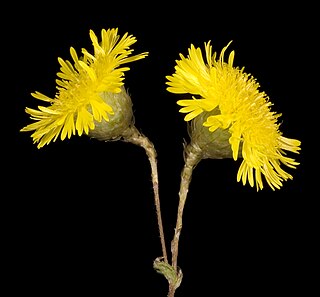
Podolepis aristata is a herb in the Asteraceae family, which is found in Western Australia, and all mainland states and territories of Australia.



















